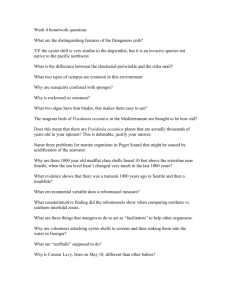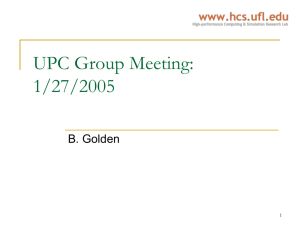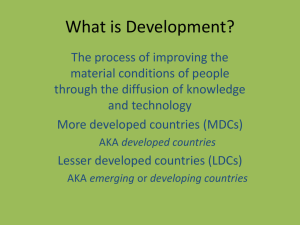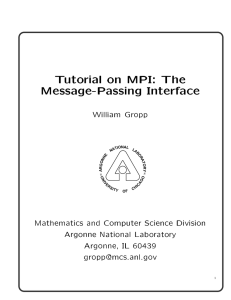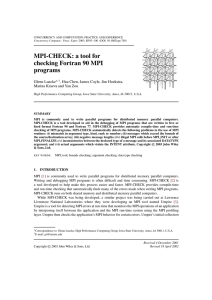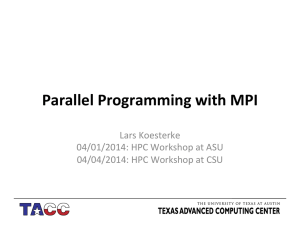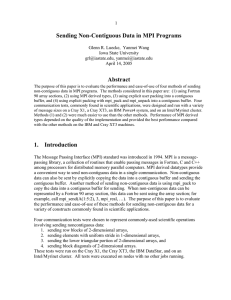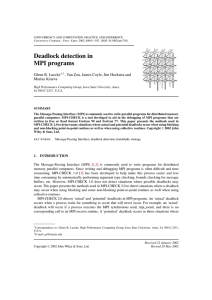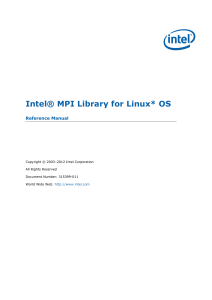Document 10662046
advertisement
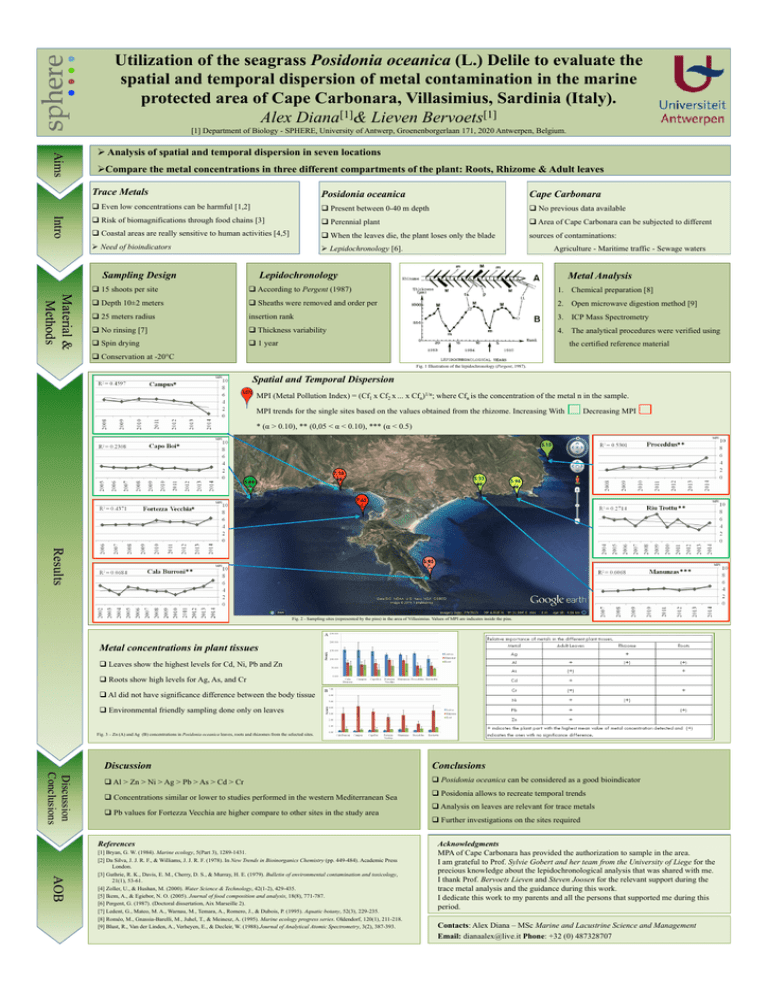
Utilization of the seagrass Posidonia oceanica (L.) Delile to evaluate the spatial and temporal dispersion of metal contamination in the marine protected area of Cape Carbonara, Villasimius, Sardinia (Italy). Alex Diana[1]& Lieven Bervoets[1] [1] Department of Biology - SPHERE, University of Antwerp, Groenenborgerlaan 171, 2020 Antwerpen, Belgium. Aims Ø Analysis of spatial and temporal dispersion in seven locations Ø Compare the metal concentrations in three different compartments of the plant: Roots, Rhizome & Adult leaves Intro Trace Metals Posidonia oceanica Cape Carbonara q Even low concentrations can be harmful [1,2] q Present between 0-40 m depth q No previous data available q Risk of biomagnifications through food chains [3] q Perennial plant q Area of Cape Carbonara can be subjected to different q Coastal areas are really sensitive to human activities [4,5] q When the leaves die, the plant loses only the blade sources of contaminations: Ø Need of bioindicators Ø Lepidochronology [6]. Sampling Design Agriculture - Maritime traffic - Sewage waters Lepidochronology Metal Analysis Material & Methods q 15 shoots per site q According to Pergent (1987) 1. Chemical preparation [8] q Depth 10±2 meters q Sheaths were removed and order per 2. Open microwave digestion method [9] q 25 meters radius insertion rank 3. ICP Mass Spectrometry q No rinsing [7] q Thickness variability 4. The analytical procedures were verified using q Spin drying q 1 year the certified reference material q Conservation at -20°C Fig. 1 Illustration of the lepidochronology (Pergent, 1987). Spatial and Temporal Dispersion MPI * MPI MPI (Metal Pollution Index) = (Cf1 x Cf2 x ... x Cfn)1/n; where Cfn is the concentration of the metal n in the sample. MPI trends for the single sites based on the values obtained from the rhizome. Increasing With Decreasing MPI * (α > 0.10), ** (0,05 < α < 0.10), *** (α < 0.5) MPI MPI ** * MPI MPI ** * Results ** MPI MPI *** Fig. 2 - Sampling sites (represented by the pins) in the area of Villasimius. Values of MPI are indicates inside the pins. A Metal concentrations in plant tissues q Leaves show the highest levels for Cd, Ni, Pb and Zn q Roots show high levels for Ag, As, and Cr q Al did not have significance difference between the body tissue B q Environmental friendly sampling done only on leaves Fig. 3 – Zn (A) and Ag (B) concentrations in Posidonia oceanica leaves, roots and rhizomes from the selected sites. Discussion Conclusions Discussion Conclusions q Al > Zn > Ni > Ag > Pb > As > Cd > Cr q Posidonia oceanica can be considered as a good bioindicator q Concentrations similar or lower to studies performed in the western Mediterranean Sea q Pb values for Fortezza Vecchia are higher compare to other sites in the study area References AOB [1] Bryan, G. W. (1984). Marine ecology, 5(Part 3), 1289-1431. [2] Da Silva, J. J. R. F., & Williams, J. J. R. F. (1978). In New Trends in Bioinorganics Chemistry (pp. 449-484). Academic Press London. [3] Guthrie, R. K., Davis, E. M., Cherry, D. S., & Murray, H. E. (1979). Bulletin of environmental contamination and toxicology, 21(1), 53-61. [4] Zoller, U., & Hushan, M. (2000). Water Science & Technology, 42(1-2), 429-435. [5] Ikem, A., & Egiebor, N. O. (2005). Journal of food composition and analysis, 18(8), 771-787. [6] Pergent, G. (1987). (Doctoral dissertation, Aix Marseille 2). [7] Ledent, G., Mateo, M. A., Warnau, M., Temara, A., Romero, J., & Dubois, P. (1995). Aquatic botany, 52(3), 229-235. [8] Roméo, M., Gnassia-Barelli, M., Juhel, T., & Meinesz, A. (1995). Marine ecology progress series. Oldendorf, 120(1), 211-218. [9] Blust, R., Van der Linden, A., Verheyen, E., & Decleir, W. (1988).Journal of Analytical Atomic Spectrometry, 3(2), 387-393. q Posidonia allows to recreate temporal trends q Analysis on leaves are relevant for trace metals q Further investigations on the sites required Acknowledgments MPA of Cape Carbonara has provided the authorization to sample in the area. I am grateful to Prof. Sylvie Gobert and her team from the University of Liege for the precious knowledge about the lepidochronological analysis that was shared with me. I thank Prof. Bervoets Lieven and Steven Joosen for the relevant support during the trace metal analysis and the guidance during this work. I dedicate this work to my parents and all the persons that supported me during this period. Contacts: Alex Diana – MSc Marine and Lacustrine Science and Management Email: dianaalex@live.it Phone: +32 (0) 487328707
